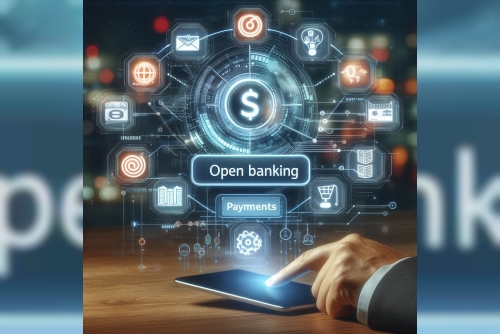Open banking payments are an important revolution in commerce, redefining the way individuals and businesses engage with their banks and payment providers. Open banking, through the power of secure data sharing via APIs, unlocks a realm of financial innovation, fostering efficiencies, lowering costs, and paving the way for more personalised services. The concept has evolved from its beginnings in the European Union to resonate globally, nurturing a more open and transparent financial ecosystem.
Let’s explore the open banking ecosystem in further detail.
What are open banking payments?Open Banking basically makes it super easy and safe to make payments. It lets people and businesses send money straight from their bank accounts without needing any middlemen. This method uses real-time data sharing and APIs to allow for instant bank payments, improving the speed and transparency of financial transactions.
Core featuresEfficiency in payment processing
Open Banking cuts out the usual payment processors, making transactions faster and cheaper. This smooth process helps both merchants and consumers by enabling instant payments, enhancing cash flow, and creating a seamless experience.
Better experience for consumers
Open Banking payments let users make secure online transactions without needing cards or manual bank transfers. When businesses add a "pay by bank" option, it helps to make the checkout process smoother. This can lead to more people completing their purchases and feeling satisfied with the overall experience.
Advantages for businesses
When businesses start using Open Banking payments, they get to tap into some pretty advanced online payment systems that offer real-time payment confirmations. This helps address problems like chargebacks, cuts down on fraud, and makes financial transparency better.
How does open banking work?Collaboration among conventional banks, fintech firms, and third-party payment processors is crucial to the open banking environment. In order to meet the unique demands of their customers, these businesses use open banking APIs to provide cutting-edge payment solutions.
The role of payment providers
Payment providers hold a significant position within the open banking ecosystem as they incorporate APIs into their platforms. Organisations such as Wonderful, Yapily, and TrueLayer provide services that allow businesses to process transactions securely and efficiently, ensuring adherence to regulations while also delivering a user-friendly interface.
Payment processors and open banking
Open Banking is reshaping the function of conventional payment processors. Providing direct access to bank accounts diminishes reliance on card networks and various intermediaries. This transition presents payment processors with the chance to innovate and maintain their relevance in the changing financial environment.
Consumer-focused innovations
Open Banking has enabled payment providers to implement features like recurring payments, budget tracking, and financial insights. These services improve customer engagement and provide businesses with a more profound understanding of consumer behaviour.
What are the standard regulatory norms governing open banking?A suitably regulated environment is essential for the success of open banking. The Payment Services Directive 2 (PSD2) of the European Union, along with its anticipated successor, PSD3, has established a solid foundation for secure and efficient open banking systems. The implementation of these regulations has played a crucial role in safeguarding customer interests and aligning standards throughout the financial ecosystem.
Security and compliance
Regulations mandate that financial institutions and third-party providers adhere to rigorous security standards. This guarantees that Open Banking payments are dependable and secure against fraud, thereby enhancing consumer confidence in the system.
Collaboration with national infrastructure
In the United Kingdom, initiatives such as the New Payments Architecture (NPA) are designed to improve open banking by offering real-time payment systems that ensure greater transparency and facilitate instant settlements. The recent advancements hold the potential to enhance open banking, making it more efficient and accessible than ever before.
International views on regulation
In addition to Europe, nations such as Australia and India have established their own frameworks, including the Consumer Data Right (CDR) and the Unified Payments Interface (UPI), respectively. The models illustrate the significant global influence of open banking in the evolution of contemporary financial systems.
Open banking and instant payments: A powerful partnershipThe combination of open banking and instant payments is changing the way transactions take place, allowing both businesses and consumers to experience remarkable speed and convenience.
Real-time settlements
Open Banking facilitates instant bank payments, enabling real-time settlements and ensuring that funds are readily accessible. This is especially advantageous for businesses that require quick cash flow to operate efficiently. Wonderful, plaid, and Tink are great exponents of this open banking feature.
Applications in various industries
The transition from retail to utilities highlights how the capability for instant payments can enhance customer engagement opportunities. For instance, service providers have the ability to receive payments immediately for subscription-based or pay-as-you-go services.
Minimising transactional barriers
Open Banking payments reduce transaction fees and delays by bypassing traditional intermediaries, enhancing the efficiency of both cross-border and domestic payments.
The road ahead: Future trendsThe future of open banking is all about evolving into broader areas, such as open finance, and blending with new technologies. These developments will boost its adoption and usefulness even more.
Transitioning from open banking to open finance
Open Finance takes the ideas of Open Banking further by broadening data-sharing options to areas such as insurance, pensions, and investments. This expansion will give consumers a complete picture of their financial health and allow for more personalised services.
Artificial Intelligence and Machine Learning in open banking
Bringing together AI and machine learning will lead to better fraud detection, tailored financial products, and smarter predictive analytics. These technologies will help both businesses and consumers make smart financial choices.
Worldwide acceptance and uniformity
Creating global standards for Open Banking APIs will make international transactions easier and encourage collaboration among financial institutions around the world. This will open up new possibilities for businesses aiming to grow in global markets.
Improved real-time features
Open Banking paired with instant payments is set to keep evolving, paving the way for fresh solutions like real-time bill payments, peer-to-peer transfers, and dynamic pricing models.
ConclusionOpen Banking signifies a monumental shift in the financial landscape, ushering in unmatched transparency, efficiency, and innovation in payment processing. By enabling instant payments and fostering collaboration among banks, fintech companies, and payment providers, it is paving the way for a more connected and customer-centric financial ecosystem. Despite the challenges ahead, the future of open banking shines with potential, set to transform our global interaction with financial services.












